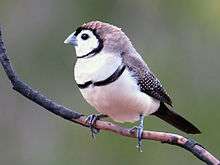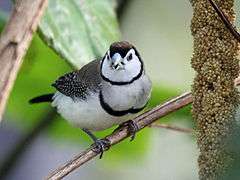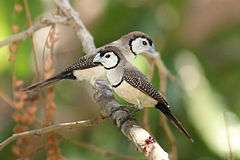Double-barred finch
| Double-barred finch | |
|---|---|
 | |
| At the Gregory River, Queensland, Australia | |
| Scientific classification | |
| Kingdom: | Animalia |
| Phylum: | Chordata |
| Class: | Aves |
| Order: | Passeriformes |
| Family: | Estrildidae |
| Genus: | Taeniopygia |
| Species: | T. bichenovii |
| Binomial name | |
| Taeniopygia bichenovii | |
The double-barred finch (Taeniopygia bichenovii) is an estrildid finch found in dry savannah, tropical (lowland) dry grassland and shrubland habitats in northern and eastern Australia. It is sometimes referred to as Bicheno's finch or as the owl finch, the latter of which owing to the dark ring of feathers around the face.
Taxonomy
Nicholas Aylward Vigors and Thomas Horsfield described the double-barred finch in 1827. The specific epithet commemorates James Ebenezer Bicheno, a colonial secretary of Van Diemen's Land appointed in September 1842. There are two subspecies:
- Taeniopygia bichenovii bichenovii of eastern Australia
- Taeniopygia bichenovii annulosa of northern and northwestern Australia, described by John Gould in 1840.
Description
The double-barred finch is a 10–11 cm long munia-like bird. It has a white face bordered with black, brown upperparts and throat, and white underparts. The throat and underparts are separated by another black line. The wings are patterned in brown and white. The sexes are similar, but juveniles are duller and browner. A less common subspecies with brown or black underparts is known to exist.
Behaviour
The double-barred finch is granivorous and highly gregarious. Nests are built in grass, bushes or low trees, with four to six eggs laid per clutch. The call is a soft tet or a louder peew, and the song is a soft fluting, which is somewhat like the zebra finch.
Origin
Origin and phylogeny has been obtained by Antonio Arnaiz-Villena et al.[2] Estrildinae may have originated in India and dispersed thereafter (towards Africa and Pacific Ocean habitats).
Gallery


.jpg) Bees Creek, Northern Territory, Australia
Bees Creek, Northern Territory, Australia Northern Territory, Australia
Northern Territory, Australia Corella Dam, Queensland
Corella Dam, Queensland
References
- ↑ BirdLife International (2012). "Taeniopygia bichenovii". IUCN Red List of Threatened Species. Version 2013.2. International Union for Conservation of Nature. Retrieved 26 November 2013.
- ↑ Arnaiz-Villena, A; Ruiz-del-Valle V; Gomez-Prieto P; Reguera R; Parga-Lozano C; Serrano-Vela I (2009). "Estrildinae Finches (Aves, Passeriformes) from Africa, South Asia and Australia: a Molecular Phylogeographic Study" (PDF). The Open Ornithology Journal. 2: 29–36. doi:10.2174/1874453200902010029. Archived from the original (PDF) on 2012-03-18.
- Finches and Sparrows by Clement, Harris and Davis, ISBN 0-7136-8017-2
External links
| Wikimedia Commons has media related to Taeniopygia bichenovii. |
